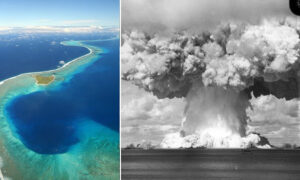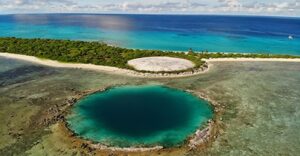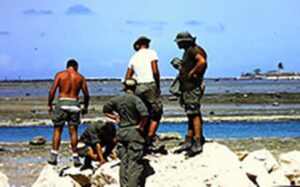
Marshall Islands Nuclear Remembrance Day is a multi-day event to honor the victims and survivors of the nuclear testing done in the Marshall Islands.
Here is some background on why remembrance remains deeply important.
Nuclear Weapons Production in Washington State
- Before the nuclear tests even started, they had a toxic legacy. The uranium that was used in the weapons was largely sourced from Midnite Mine, a uranium mine that was built on the Spokane Tribe of Indians’ Reservation creating massive contamination for the community. The Spokane Tribe of Indians were heavily impacted by the adverse health effects caused by Midnite Mine. Despite closing in 1981, it was listed as a Superfund site in 2000, and the clean-up of the mine did not begin until 2017, allowing waste to pollute the area for 36 years.
- Additionally, the nuclear weapons that were tested on the Marshall Islands utilized plutonium that was produced at Hanford. Hanford is a former nuclear weapons site in the Tri cities, established as part of the Manhattan Project in 1943. Located on the ancestral lands of the Yakama Nation, Hanford is home of the B reactor, the first full-scale plutonium production reactor in the world. It was responsible for producing plutonium for the bomb dropped in Nagasaki as well as the first nuclear weapons ever tested in New Mexico. Hanford is now the largest environmental clean-up effort in the world, and the most contaminated site in the western hemisphere.

1946-1958: United States Nuclear Testing
- When the Marshallese community tended to negotiate further treaties and establishments with Americans, they did not expect massive destruction to occur on their islands.
- Following other colonial regimes, Japan established military bases in the Marshall Islands in 1914. They expected the Marshallese to assimilate into their war efforts and colonial era to gain their power away from American colonialism. Although the Marshallese were mistreated by the Japanese, they did not want to acknowledge anything else with them as they saw American power tend to be gained. In 1944, during WWII, the United States defeated Japanese troops in the Marshall Islands and converted their bases into U.S. bases.
- About 2 years later, during the early years of the Cold War, the United States decided to utilize its military presence in the Marshall Islands to conduct nuclear tests.
- Between 1946 and 1958, the U.S. conducted 67 nuclear tests on the Marshall Islands. The Bravo detonation that took place in 1954 was the most massive nuclear weapon ever detonated by the United States – and it was accompanied by many other massive-scale detonations. This testing of atomic and hydrogen bombs amounted to one Hiroshima bomb every day, for 12 years. The fallout spread throughout the islands.
- The U.S. Government had decided not to evacuate downwind communities, and after the explosions, enrolled residents of the downwind Rongelap and Utrik communities into a secret medical experimentation program.
- Around 200 people whose islands were directly bombed were relocated to different islands during the tests; during this time, many communities faced malnutrition and starvation due to inadequate resources.
- The U.S. dispatched American soldiers and civilian contractors for nuclear clean-up, without informing them of the nuclear radiation risk they would be taking on. Those involved in the clean-up process were also not provided with adequate personal protective gear. Today, these clean-up veterans and civilian contractors have extremely high rates of cancer, with some individuals developing multiple different forms.
- This testing changed the lives of the Marshallese significantly. The detonations threatened the well-being of Marshallese communities when they first occurred, and the pollution has since made the previously-available natural resources scarce.


1986: Compact of Free Association (COFA)
- In 1986, the U.S. signed the Compact of Free Association into law. COFA is an international agreement with the U.S. and the Republic of the Marshall Islands (RMI) as well as the Republic of Palau and the Federated States of Micronesia.
- COFA states that Marshallese people have the right to live and work in the U.S. and can even serve in the U.S. military. However, Marshallese people do not have an automatic right to permanent residency.
- A 1996 federal welfare reform act made COFA communities ineligible for Medicaid: this posed a major issue, as many COFA communities have high rates of chronic diseases and health issues due to the legacy of U.S. nuclear testing.
- Recent victory: in 2020, due to the effort of amazing organizers, COFA islanders residing in the U.S. became eligible once again for Medicaid
Today: Lingering Impacts
- The health injustices that these nuclear tests caused, including cancer, thyroid disorders, stunted growth, developmental delays, and birthing anomalies, are still being felt by many, including Marshallese elders, children, and cleanup veterans.
- The contamination still lingers in the soil, water, and local food of certain areas. The populations of Bikini and Rongelap have still not been able to return to their islands due to toxic contamination as well as segments of the Enewetak community.
- Today’s climate crisis poses yet another layer of risk to the Marshall Islands. As the sea level rises, large sections of the Marshall Islands are at risk of being submerged.
- This is particularly concerning because, during the “clean-up” process, the U.S. moved contaminated debris and soil to Runit Island and dumped it into a crater that was later filled with concrete. Today, as the water rises, researchers have cited concern that this tomb of atomic contamination may be vulnerable to leaking if exposed to sea level rise and storms.
- The Runit Dome is a control structure located on Enewetak Atoll. Enewetak Atoll is a previous U.S. air atomic weapon test site in the Marshall Islands. According to the Department of Energy (DOE), the amount of plutonium beneath the dome surface contains one percent of the overall amount buried in the sediments of the nearby lagoon, and is less than 0.1 percent of the plutonium produced more than 60 years ago during weapon tests.
- The pervasive COVID-19 is constraining the Marshallese population to confront the immense imbalances in our environment that have made this virus more dangerous in a few communities than in others. Moreover, this is also valid within the world of nuclear weapons tests have, and continue to do, damage to societies across a hurtful and often dangerous radius.

- In the forthcoming month of March, the Marshallese community in Spokane, Washington, will have this vital history. Come join us to remember this important history, honor the brave work of frontline communities and unite in battling for equity that is long overdue. It will be in fortitude with other Marshallese narrators, and other affected networks in Washington state, and across the US. Particularly during this season of disengagement, we will be hosting this event online to ensure these accounts keep on being told and permit a period for aggregate mending in recognition of the people in question/survivors to the ages that follow. We need to perceive the flexibility and strength of transcending atomic forces, enhance the voices that should be heard, and remind this community that we are not alone.
Event logistics
Marshall Islands Nuclear Remembrance Day will take place March 15-20 2021, and will be virtual.
You can also register at: https://www.cann-wa.us/our-work

